Complete Solutions to Example of chapter Current Electricity of Class 12 book with complete answers and questions
| Class 12 | PHYSICS |
| Chapter | Current Electricity |
| CHETANA PUBLICATION | Example |
| Number Of Questions | 95 |
| Academic Year | 2023-24 |
What do you mean by current electricity?
01:18View SolutionName the three types of electrical conductors?
00:55View SolutionDoes a semiconductor diode and resistor have similar electrical properties?
01:22View SolutionWhat is the effective resistance when two or more resistors are connected in series?
01:28View SolutionWhat is the effective resistance when two or more resistors are connected in parallel?
01:19View SolutionName the laws used for analyzing complicated circuits?
01:08View SolutionGive the basic difference between the electrical properties of a semiconductor diode and resistor?
01:57View SolutionDefine junction.
01:12View SolutionDefine loop or mesh.
02:45View SolutionDefine branch.
01:37View SolutionState the uses of Kirchhoff's Laws.
01:09View SolutionAre Kirchhoff's Laws applicable for both AC and DC currents.
01:15View SolutionState Kirchhoff's Laws.
04:06View SolutionExplain : Kirchhoff's first laws is in accordance with law of conservation of charge.
00:47View SolutionExplain: Kirchhoff's second law is in accordance with law of conservation of energy.
01:50View SolutionState and explain the sign conventions for Kirchhoff's first law.
01:44View SolutionState and explain the sign conventions for Kirchhoff's first law.
01:44View SolutionWrite down Steps followed while solving a problem using Kirchhoff's laws:
02:56View SolutionFigure shows currents in a part of electrical circuit. Find the current I?
02:09View SolutionTwo batteries of 7 volt and 13 volt and internal resistances 1 ohm and 2 ohm respectively are connected in parallel with a resistance of 12 ohm. Find the current through each branch of the circuit and the potential difference across 12-ohm resistance.
04:26View SolutionA battery of emf 4 volt and internal resistance `1 Omega`is connected in parallel with another battery of emf 1 V and internal resistance `1 Omega` (with their like poles connected together). The combination is used to send current through an external resistance of `2 Omega`. Calculate the current through the external resistance.
04:21View SolutionTwo cells of emf 1.5 Volt and 2 Volt having respective internal resistances of `1 Omega` and `2 Omega` are connected in parallel so asto send current in same direction through an external resistance of `5 Omega`. Find the current through the external resistance.
08:48View SolutionA voltmeter has a resistance `30 Omega`. What will be its reading, when it is connected across a cell of emf 2 V having internal resistance `10 Omega`?
02:55View SolutionA set of three coils having resistances `10 Omega`, `12 Omega` and `15 Omega` are connected in parallel. This combination is connected in series with series combination of three coils of the same resistances. Calculate the total resistance and current through the circuit, if a battery of emf 4.1 Volt is used for drawing current.
03:23View SolutionA voltmeter has a resistance of `100 Omega`. What will be its reading when it is connected across a cell of emf 2 V and internal resistance `20 Omega`?
01:47View SolutionName the factors affecting the resistance of a material.
02:03View SolutionWhich are conjugate arms in the Wheatstone's bridge? Why?
01:41View SolutionState the applications of Wheatstone Bridge? Why?
02:24View SolutionObtain balancing condition in case of Wheatstone Network. (By using Kirchhoffs law Obtain balancing condition in case of Wheatstone Network)
08:16View SolutionObtain balancing condition in case of Wheatstone's network. (By using Ohm's law.)
02:33View SolutionAt what value should the variable resistor be set such that the bridge is balanced? If the source voltage is 30 V find the value of the output voltage across XY, when the bridge is balanced.
08:34View SolutionWhy meter bridge is also called Wheatstone’s metre bridge.
01:27View SolutionDoes the value of resistance of a conductor depend upon the potential difference applied across it or current passed through it?
02:13View SolutionDescribe the construction of meter bridge to determine an unknown resistance.
05:51View SolutionExplain with neat circuit diagram, how you wil determine the unknown resistance using a meter bridge.
07:07View SolutionFour resistance `10 Omega`, `10 Omega`,`10 Omega` and `20 Omega` are connected so as to form Wheatstone's bridge. The resistance connected across `20 Omega` resistance to balance the bridge is
03:20View SolutionDescribe the construction Kelvin's method to determine the resistance of Galvanometer by using meter bridge.
05:55View SolutionDefine potentiometer.
01:13View SolutionWhat is a potentiometer?
02:07View SolutionDo you know an instrument which can measure terminal P.D. as well as e.m.f.?
01:18View SolutionName the device used for the measurement of internal resistance of a cell.
01:28View SolutionWhy there is no way to separate the internal resistance from the e.m.f. of a cell?
02:01View SolutionOn what factors does the internal resistance of a cell depend?
02:50View SolutionIs internal resistance a defect of a cell? Explain.
02:39View SolutionState the advantages of potentiometer over voltmeter.
03:25View SolutionState the disadvantages of potentiometer over voltmeter.
02:33View SolutionWhy is potentiometer preferred over a voltmeter for measuring emf? or explain. Potentiometer acts as an ideal voltmeter .
03:59View SolutionState and explain principle of potentiometer.
06:07View SolutionDescribe the construction of potentiometer.
04:54View SolutionDefine potential gradient. State its unit and dimension.
01:47View SolutionObtain the dimension of potential gradient.
01:42View SolutionOn what factors does a potential gradient of a wire depend.
01:43View SolutionWhat is potential gradient? How it is measured? Explain.
02:56View SolutionWhy jockey should not be slided along the potentiometer wire?
01:53View SolutionState the uses of a potentiometer.
02:46View SolutionState what precautions must be taken while performing experiment with potentiometer.
03:22View SolutionDescribe the use of potentiometer to compare the e.m.f. of two cells by the direct method (individual method).
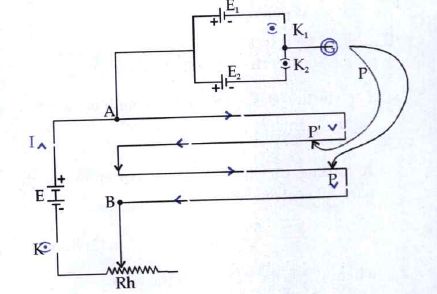 06:20View Solution
06:20View SolutionDescribe how a potentiometer is used to compare the e.m.f.s of two cells by connecting them separately.
 07:58View Solution
07:58View SolutionDescribe how potentiometer is used to compare the e.m.f.s of two cells by combination method.
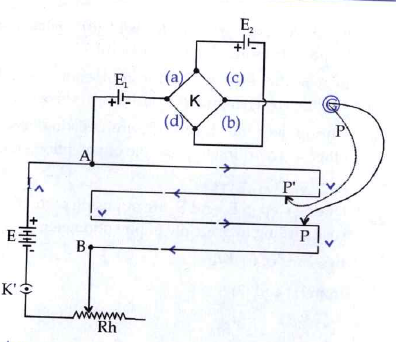 05:39View Solution
05:39View SolutionDescribe with the help of neat diagram how will you determine the internal resistance of a cell by using potentiometer. Derive the necessary formula.
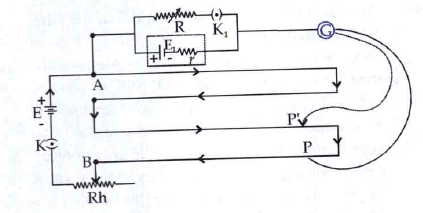 07:24View Solution
07:24View SolutionExplain the use of potentiometer for determining he internal resistance of cell.
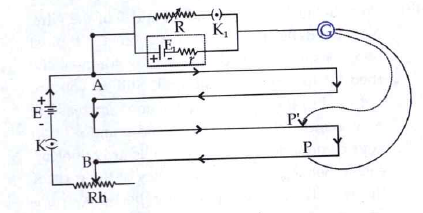 07:42View Solution
07:42View SolutionWhat will be the effect on the position of zero deflection if only the current flowing through the potentiometer wire is Explain:- increased
01:53View SolutionWhat will be the effect on the position of zero deflection if only the current flowing through the potentiometer wire is:- decreased.
01:47View SolutionA potentiometer wire has a length of 1.5 m and resistance of `10 Omega`. It is connected in series with the cell of emf 4 Volt and internal resistance `5 Omega`. Calculate thepotential drop per centimeter of the wire.
02:13View SolutionWhen two cells of emfs. `E_1` and `E_2` are connected in series so as to assist each other, their balancing length on a potentiometer is found to be 2.7 m. When the cells are connected in series so as to oppose each other, the balancing length is found to be 0.3 m. Compare the emfs of the two cells.
01:44View SolutionIn an experiment to determine the internal resistance of a cell of emf 1.5 V, the balance point in the open cell condition is 76.3 cm. When a resistor of 9.5 ohm is used in the external circuit of the cell the balance point shifts to 64.8 cm of the potentiometer wire. Determine the internal resistance of the cell.
02:16View SolutionThe emf of a cell is balanced by a length of 120 cm of potentiometer wire. When the cell is shunted by a resistance of `10 Omega`, the balancing length is reduced by 20 cm. Find the internal resistance of the cell.
01:45View SolutionA potential drop per unit length along a wire is `5 xx 10^-3 V//m`. If the emf of a cell balances against length 216 cm of this potentiometer wire, find the emf of the cell.
01:46View SolutionThe resistance of a potentiometer wire is `8 Omega`and its length is 8 m. A resistance box and a 2V battery are connected in series with it. What should be the resistance in the box, if it is desired to have a potential drop of `1muV//mm`?.
03:09View SolutionWhat is a Galvanometer?
02:29View SolutionWhat are the types of moving coil Galvanometer?
01:32View SolutionState the principle of moving coil Galvanometer?
02:09View SolutionWith the help of neat diagram, describe the theory of moving coil Galvanometer?
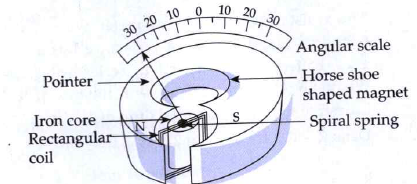 04:57View Solution
04:57View SolutionState the modification necessary to convert a moving col Galvanometer into ammenter?
03:46View SolutionState the uses of shunt connected across, Galvanometer.
02:40View SolutionExplain how a moving coil Galvanometer is converted into an ammeter. Derive the necessary formula.
06:09View SolutionIf I = n Ig then in moving coil Galvanometer. Show that:- `S=G/(n-1)`
03:17View SolutionIf I = n Ig then in moving coil Galvanometer. Show that:- `(Is)/I=G/(S+G)`
03:59View SolutionA galvanometer has a resistance of `100 Omega` and its full scale deflection current is `100 mu A`. What shunt resistance should be added so that the ammeter can have a range of 0 to 10 mA ?.
01:54View SolutionWhat is the value of the shunt resistance that allows 20% of the main current through a galvanometer of `99 Omega`?.
02:08View SolutionState the modification necessary to convert a moving coil galvanometer into voltmeter.
02:09View SolutionState the uses of resistance connected in series with the galvanometer.
02:11View SolutionExplain how a moving coil galvanometer is converted into voltmeter. Derive the necessary formula.
03:48View SolutionIf V = `n_v V_g` then show that X = G`(n_v -1)`.
03:16View SolutionA Galvanometer has a resistance of `25 Omega` and its full scale deflection current is `25 muA`. What resistance should be added to it to have a range of 0 -10 V.
02:04View SolutionA Galvanometer has a resistance of 40 D and a current of 4 mA is needed for a full scale deflection. What is the resistance and how is it to be connected to convert the galvanometer:- into an ammeter of 0.4 A range and
03:27View SolutionA Galvanometer has a resistance of 40 D and a current of 5 mA is needed for a full scale deflection. What is the resistance and how is it to be connected to convert the galvanometer:- into a voltmeter of 0.5 V range?
02:40View SolutionWhat is called thermoelectric effect?
01:54View SolutionWho discovered thermoelectric effect?
02:12View SolutionExplain thermoemf, seeback effect and thermocouple?
04:54View SolutionGive two examples of thermocouple using diagram?
03:57View SolutionWrite the equation for thermo emf when cold junction is at `0^@C` and the hot junction is at `T^@C` what will be the shape of graph showing variation of thermo emf with a temperature?
01:52View SolutionDistinguish between potentiometer and voltmeter..
03:55View SolutionDistinguish between Meterbridge experiment and Kelvin's method.
02:42View SolutionDistinguish between ammeter and voltmeter.
02:54View Solution
Example questions and complete solutions for chapter Current Electricity of CHETANA PUBLICATION of Class 12
